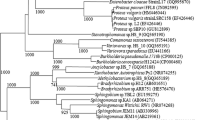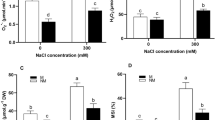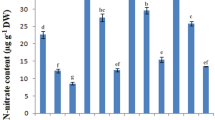Abstract
Soil salinity and Zn deficiency are among the major limiting factors for growth and improvement of pistachio trees in central Iran. Using plant growth promoting rhizobacteria (PGPR) is new strategy to reduce the destructive effects of salinity and improvement of nutrient availability. This study investigated the individual and the interactive effects of the PGPR and Zn treatments on some physiological and biochemical parameters, antioxidant enzymes activities and alleviation of salinity stress in pistachio seedlings. The treatments include isolates of fluorescent pseudomonads as PGPR [control (non-inoculated), pf1, pf2 and pf3], Zn (0 and 5 mg kg−1 soil) and salinity (0, 1000 and 2000 mg NaCl kg−1 soil). The results indicated that salinity increased the proline, soluble sugars and H2O2 concentrations in the seedling leaves and roots. Inoculation with PGPR efficiently enhanced the concentrations of proline (35 and 16 %) and the soluble sugars (25 and 22 %), whereas, reduced the H2O2 levels (16 and 18 %) in the leaves and roots. Increasing the concentration of NaCl to 2000 mg kg−1 significantly decreased the dry weight, Zn concentration, and chlorophyll and carotenoids contents. At the same salinity level, the PGPR and Zn alone increased these parameters compared to the untreated soil, but furthest by the combined PGPR and Zn treatments. Also, the combined application of PGPR and Zn significantly increased the antioxidant enzyme activities and protein concentration relative to their sole usage in the pistachio seedling leaves and roots, especially at the higher salinity levels. The isolates containing ACC-deaminase activity were more efficient to alleviate salt stress and develop seedling improvement.





Similar content being viewed by others
Abbreviations
- ACC:
-
1-Aminocyclopropane-1-carboxylate
- CAT:
-
Catalase
- CFU:
-
Colony forming unit
- IAA:
-
Indole acetic acid
- PGPR:
-
Plant growth promoting rhizobacteria
- POX:
-
Peroxidase
- PPO:
-
Polyphenol oxidase
- ROS:
-
Reactive oxygen species
- RWC:
-
Relative water content
- SOD:
-
Superoxide dismutase
- Chl.:
-
Chlorophyll
- Car.:
-
Carotenoids
References
Abbas-Zadeh P, Saleh-Rastin N, Asadi-Rahmani H, Khavazi K, Soltani A, Shoary-Nejati R, Miransari M (2010) Plant growth-promoting activities of fluorescent pseudomonads isolated from the Iranian soils. Acta Physiol Plant 32:281–288
Ali Sh, Charles TC, Glick BR (2014) Amelioration of high salinity stress damage by plant growth promoting bacterial endophytes that contain ACC deaminase. Plant Physiol Biochem 80:160–167
Alloway BJ (2008) Zinc in soils and crop nutrition. Second edition, published by IZA and IFA, Brussels, Belgium and Paris, France
Alqarawi AA, Hashem A, Abd Allah EF (2014) Alleviation of salt-induced adverse impact via mycorrhizal fungi in Ephedra aphyllaForssk. J Plant Interact 9:802–810
Aravind P, Prasad MNV (2004) Zinc protects chloroplasts and associated photochemical functions in cadmium exposed Ceratophyllumdemersum L. a fresh water macrophyte. Plant Sci 166:1321–1327
Arif M, Shehzad MA, Bashir F, Tasneem M, Yasin G, Iqbal M (2012) Boron, zinc and microtone effects on growth, chlorophyll contents and yield attributes in rice (Oryza sativa L.) cultivar. AfrJ Biotechnol 11:10851–10858
Bradford M (1976) A rapid and sensitive method for the quantitation of protein utilizing the principle of protein-dye binding. Ann Rev Biochem 72:248–254
Cakmak I (2000) Possible roles of zinc in protecting plant cells from damage by reactive oxygen species. New Phytol 146:185–205
Cakmak I, Marschner H (1992) Magnesium deficiency and high light intensity enhance activities of superoxide dismutase, ascrobate peroxidase, and glutathione reductase in bean leaves. Plant Physiol 98:1222–1227
Chapman HD, Pratt PF (1961) Methods of analysis for soils, plants, and waters. University of California, Riverside
Claussen W (2005) Proline as a measure of stress in tomato plants. Plant Sci 168:241–248
Dang HR, Li Y, Sun X, Zhang Y (2010) Absorption, accumulation and distribution of zinc in highly yielding winter wheat. AgricSci China 9:965–973
Dhindsa RS, Plump-Dhindsa P, Thorpe TA (1981) Leaf senescence: correlated with increased levels of membrane permeability and lipid peroxidation, and decreased levels of superoxide dismutase and catalase. J Exp Bot 32:93–101
Ding M, Hou P, Shen X (2010) Salt-induced expression of genes related to Na+/K+ and ROS homeostasis in leaves of salt-resistant and salt-sensitive poplar species. Plant MolBiol 73:251–269
Eckardt NA (2009) A new chlorophyll degradation pathway. Plant Cell 21:700
Egamberdieva D (2012) Pseudomonas chlororaphis:a salt-tolerant bacterial inoculants for plant growth stimulation under saline soil conditions. Acta Physiol Plant 34:751–756
Egamberdieva D, Kucharova Z (2009) Selection for root colonizing bacteria stimulating wheat growth in saline soils. BiolFertil Soil 45:563–571
Gill SS, Tuteja N (2010) Reactive oxygen species and antioxidant machinery in abiotic stress tolerance in crop plants. Plant Physiol Biochem 48:909–930
Gonzalez L, Gonzalez-Vilar M (2003) Determination of relative water content. In: Reigosa MJ (ed) Handbook of plant ecophysiology techniques. Kluwer Academic, Dordrecht, pp 207–212
Gururani MA, UpadhyayaChP Basker V, Venkatesh J, Nookaraju A, Park SW (2013) Plant Growth-Promoting Rhizobacteria Enhance Abiotic Stress Tolerance in Solanumtuberosum Through Inducing Changes in the Expression of ROS-Scavenging Enzymes and Improved Photosynthetic Performance. J Plant Growth Regul 32:245–258
Habibi GH, Norouzi F, Hajiboland R (2014) Silicon alleviates salt stress in pistachio plants. Prog Biolog Sci 4:189–202
Halliwell B, Gutteridge JMC (2007) Free radicals in biology and medicine, 4th edn. Oxford University Press, Oxford
Han HS, Lee KD (2005) Plant growth promoting rhizobacteria effect on antioxidant status, photosynthesis, mineral uptake and growth of lettuce under soil salinity. Res J AgricBiolSci 1:210–215
Hernandez M, Kappler A, Newman D (2004) Phenazines and other redox-active antibiotics promote microbial mineral reduction. Appl Environ Microbiol 70:921–928
Iqbal M, Ashraf M (2013) Alleviation of salinity-induced perturbations in ionic and hormonal concentrations in spring wheat through seed preconditioning in synthetic auxins. Acta Physiol Plant 35:1093–1112
Irigoyen JJ, Emerich DW, Sanchez-Diaz M (1992) Water stress induced changes in concentrations of proline and total soluble sugars in nodulated alfalfa (Medicago sativa) plants. Physiol Plant 84:55–60
Karlding H, Yildirim E, Turan M, Pehluvan M, Donmez F (2013) Plant growth-promoting rhizobacteria mitigate deleterious effects of salt stress on strawberry plants (Fragaria × ananassa). HortSci 48:563–567
Karuppanapandian T, Moon JC, Kim Ch, Manoharan K, Kim W (2011) Reactive oxygen species in plants: their generation, signal transduction, and scavenging mechanisms. AJCS 5:709–725
Khoshgoftar AH, Shariatmadari H, Karimian N, Kalbasi M, van der Zee SEATM, Parker DR (2004) Salinity and zinc application effects on phytoavailability of cadmium and zinc. Soil Sci Soc Am J 68:1885–1889
Lichtenthaler HK, Wellburn AR (1983) Determinations of total carotenoids and chlorophylls a and b of leaf extracts in different solvents. Biochem Soc Trans 11:591–592
Lindsay WL (1978) Chemical equilibria in soil. Wiley, New York
Lopez-Huertas E, Del Río L (2014) Characterization of antioxidant enzymes and peroxisomes of olive (Oleaeuropaea L.) fruits. Plant Physiol 171:1463–1471
Marschner H (1995) Mineral nutrition of higher plants. Academic Press, Londan
Mayak S, Tirosh T, Glick BR (2004) Plant growth-promoting bacteria confer resistance in tomato plants to salt stress. Plant PhysiolBiochem 42:565–572
Mishra M, Kumar U, Mishra PK, Prakash P (2010) Efficiency of plant growth promoting rhizobacteria for the enhancement of Cicerarietinum L. growth and germination under salinity. AdvBiol Res 4:92–96
Mozaffari V, Malakouti MJ (2006) An investigation of some causes of die-back disorder of Pistachio trees and its control through balanced fertilization in Iran. Acta Hort 726:247–252
Munns R (2002) Comparative physiology of salt and water stress. Plant Cell Environ 25:239–250
Pandolfini T, Gabbrielli R, Comparini C (1992) Nickel toxicity and peroxidase activity in seedling of Triticumaestivum L. Plant Cell and Environ 15:719–725
Paquin R, Lechasseur P (1979) Observation’s suruneméthode de dosage de la praline libredans les extraits de plantes. Can J Bot 57:1851–1854
Parida AK, Das AB (2005) Salt tolerance and salinity effects on plants: a review. Ecotox Environ Safe 60:324–349
Paul D, Nair S (2008) Stress adaptations in a plant growth promoting Rhizobacterium (PGPR) with increasing salinity in the coastal agricultural soils. J Basic Microb 48:1–7
Porcel R, Aroca R, Ruiz-Lozano JM (2012) Salinity stress alleviation using arbuscularmycorrhizal fungi: a review. Agron Sustain Dev 32:181–200
Porra RJ (2002) The chequered history of the development and use of simultaneous equations for the accurate determination of chlorophylls a and b. Photosynth Res 73:149–156
Qurashi AW, Sabri AN (2012) Bacterial exopolysaccharide and biofilm formation stimulate chickpea growth and soil aggregation under salt stress. Braz J Microbiol 43:1183–1191
Sairam RJ, Veerabhadra R, Srivastava GC (2002) Differential response of wheat genotypes to long term salinity stress in relation to oxidative stress, antioxidant activity and osmolyte concentration. Plant Sci 136:1046–1073
Saleem M, Arshad M, Hussain S, Bhatti A (2007) Perspective of plant growth promoting rhizobacteria (PGPR) containing ACC deaminase in stress agriculture. J IndMicrobiolBiotechnol 34:635–648
Saravanakumar D, Samiyappan R (2007) ACC deaminase from Pseudomonas fluorescens mediated saline resistance in groundnut (Arachis hypogea) plants. J ApplMicrobiol 102:1283–1292
Shahriaripour R, Tajabadi Pour A, Mozaffari V, Dashti H, Adhami E (2010) Effects of salinity and soil zinc application on growth and chemical composition of pistachio seedlings. J Plant Nutr 33:1166–1179
Sharma A, Shankhdhar D, Sharma A, Shankhdhar SC (2014) Growth promotion of the rice genotypes by pgprs isolated from rice rhizosphere. J Soil Sci Plant Nutr 14:505–517
Silva GR, Koblitz MGB (2010) Partial characterization and inactivation of peroxidases and polyphenol-oxidases of umbu-cajá (Spondias spp.). CiêncTecnol Aliment Campinas 30:790–796
Sparks DL (1996) Methods of soil analysis. Part. 3, chemical methods.Soil science society of America, Madison, Wisconsin, USA
Stefan M, Munteanu N, Stoleru V, Mihasan M (2013) Effects of inoculation with plant growth promoting rhizobacteria on photosynthesis, antioxidant status and yield of runner bean. Rom Biotech Lett 18:2
Sziderics AH, Rasche F, Trognitz F, Wilhelm E, Sessitsch A (2007) Bacterial endophytes contribute to abiotic stress adaptation in pepper plants (Capsicum annuum L.). Can J Microb 53:1195–1202
Tavallali V, Rahemi M, Maftoun M, Panahi B, Karimi S, Ramezanian A, Vaezpour M (2009) Zinc influence and salt stress on photosynthesis, water relations, and carbonic anhydrase activity in pistachio. Scientia Hort 123:272–279
Velikova V, Yordanov I, Edreva A (2000) Oxidative stress and some antioxidant system in acid rain treated bean plants: protective role of exogenous polyamines. Plant Sci 151:59–66
Yaman K, Taniguchi M, Kawasaki M, Miyake H (2008) Correlation between chloroplast ultrastructure and chlorophyll fluorescence characteristics in the leaves of rice (Oryza sativa L.) grown under salinity. Plant Product Sci 11:139–145
Yoshiba Y, Kiyosue T, Nakashima K, Yamaguchi-Shinozaki K, Shinozaki K (1997) Regulation of levels of proline as an osmolyte in plants under water stress. Plant Cell Physiol 38:1095–1102
Acknowledgments
We thank to the Vali-e-Asr University of Rafsanjan research council for providing financial support (Grant Number: 4-9164455). Also, we are most grateful to two anonymous referees for providing the critical comments and helpful suggestions on the original version of the manuscript.
Author information
Authors and Affiliations
Corresponding author
Additional information
Communicated by A. Krolicka.
Rights and permissions
About this article
Cite this article
Azarmi, F., Mozafari, V., Abbaszadeh Dahaji, P. et al. Biochemical, physiological and antioxidant enzymatic activity responses of pistachio seedlings treated with plant growth promoting rhizobacteria and Zn to salinity stress. Acta Physiol Plant 38, 21 (2016). https://doi.org/10.1007/s11738-015-2032-3
Received:
Revised:
Accepted:
Published:
DOI: https://doi.org/10.1007/s11738-015-2032-3




